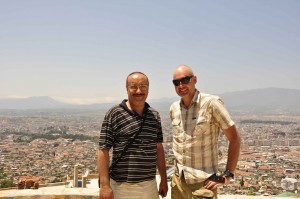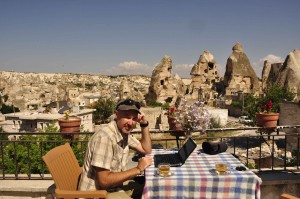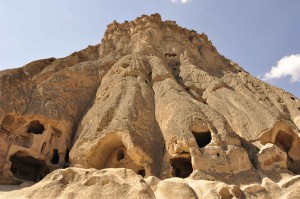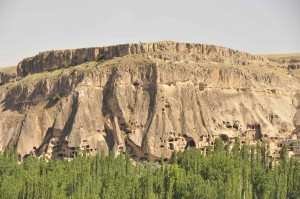You would think after 2 months of exploring ancient cities, ruins and cave dwellings, we would get a bit tired of all this. But every destination somehow entices, re-invigorates and sets wild the imagination in new ways. In all likelihood I also possess some strange, exotic historic positivity gene I suppose.
After our border shenanigans in Syria, we arrived in Antakya, Turkey mid morning only to find the connecting bus to Cappidocia was full and we were going to have to wait until 8.30pm that evening for another. Resigned to the delay, we set about a late breakfast at the Otogar – the amazing Turkish bus depots that seem to operate like airports here, with their myriad of services, restaurants and comforts. Figuring we had about 8 hours to kill, we inquired after a service bus into town and were instead offered a lift by a genial older gentleman named Burtak. Speaking little English, but with the aid of numerous hand gestures, some French and a few pages of a pretty limiting Japanese–Turkish glossary (mostly food references) in Megumi’s guide book, he proceeded to take us on a guided tour of his town. At first we weren’t too sure of his angle, being the somewhat wary travelers that we have had to become at times. A trip up to the hills overlooking the city in order to show us the great cave cathedral where Paul and Peter met in a series of meetings that laid the foundation for the modern Christian church, pretty much convinced us of his genuine enthusiasm and commitment to taking us on a tour though.
From a series of hand gestures and the odd successfully translated phrase we worked out that he was a teacher and worked to rehabilitate people suffered from head injuries or something like that – if not it was a beautiful lost in translation exercise. He then drove us about the picturesque town of Antakya (or Antioch as it was once known) for the better part of an hour; all of which gave off every feeling of having arrived at the Mediterranean and indeed the western world. Women wore tight clothing, hair and skin was displayed freely, sidewalks abounded with café’s and familiar brands with their requisite advertising popped up everywhere. It was all very welcome. We said goodbye to Burtak (a really fabulous gesture of hospitality) at a fascinating museum full of Byzantium Mosaics, then spent the afternoon patrolling the pleasant shops, restaurants and eateries either side of the river, people spotting and eventually settling into a pub to watch a world cup quarter final.
The next morning we arrived in Goreme, Cappidocia after catching possibly the most impressive overnight busride of my life. The back of each bus seat actually had its own TV monitor similar to those in the latest airplanes to chose movies from, plus USB ports so that we could review photos or listen to MP3’s etc. It was still early in the morning, but any claims to tiredness were easily overcome by the mystique cast by the towering rock formations growing up all over town. We set about exploring the place and found a nice pension with rooms carved into the rock-face (ie a cave room), with beds directly carved out of the mountainside itself and featured nice views over the stunning surrounding valley. Rooms are relatively cheap here as there is plenty of competition in town and the locals are very friendly. I had already forged a blood bond with a neighbour over our shared Anzac / WW1 tradition while checking out a room. It boded well – unpacked, breakfasted & relaxed – we had finally arrived.
Cappidocia is one of those places you would expect to only exist in children’s books. Strewn with valleys of strange ‘soft-serve’ shaped rock formations and towers of basalt, its curious geology has attracted people here since the Hittites in ancient times. The region features some 200 underground cities carved up to 7 stories below ground. While the basalt towers themselves have housed monasteries, churches, pigeons and people since the times of Christ – thousands of rock caves and homes are carved into the rock formations everywhere the eye can see. The towers themselves are known as fairy chimneys, because passing travelers on the old silk road, would see candle lights set in the holes of rocks towers from the many hermits and monks ensconced here. To the passers by though, it appeared as though fairy were at play amongst the eerie landscape. It’s a remarkably easy tale to believe actually, the place has that magical quality to it.
These days Goreme, one of the many small villages in the Cappidocia expanse is tourist grand central. Hundreds of pensions have been carved into the surrounding rocks and the village centre has been transformed into an epicenter for all the corresponding creature comforts, with a myriad of restaurants, bars and gift shops competing for attention. Just a short walk from this in seemingly every direction though, life remains much the same and villagers go about their daily life the same way as ever. Surrounding valleys are covered with grape vines on plots established long ago and brought under cultivation through the harvesting of pigeon shit via pigeon holes (houses) carved into many of the rock towers. Seriously, everywhere you look you can see the small holes at the top of the rock formations that served as pigeon fertilizer factories! Donkeys and horses still patrol the village roads and fields around and after dusk all the villagers tend to congregate outside their houses for tea and Nargilehs(water pipes) with the extended family in almost timeless fashion.
Naturally there is no shortage of tours or tour companies here, keen to package the sights. We signed up for a tour to visit some of the more far flung highlights and spent a whole day stopping at different viewpoints and experiencing the largest of the underground cities in Derinkuyu; a fascinating multilevel, 7 story, labyrinth below ground. Initially these were used by the Hittites simply for food storage and cooking in ancient times, but subsequently expanded by the early Christians in the Byzantine era to become full serving vertical villages defendable from persecuting invaders. Complete with churches and innumerable hidey holes, storage rooms, ventilation shafts and other spaces we can only begin to imagine uses for, each village is also amazingly connected to the next several kilometers away by a series of sealing tunnels far below ground as part of their defense network.
We also explored the Ilhra valley where numerous churches are carved into the valley walls and the stunning ‘Selene monastery’, a complex carved into a mountain with innumerable halls, rooms and other levels rising up the mountain rock-face. We then finished the day by soaking up the stunning sunset over Goreme and the cascading evening shades of the Pigeon, Rose and other surrounding valleys. We have done more sunsets in the last year than I can remember ever consciously doing. It just doesn’t seem to get tired, but our photography skills are really not improving at all with the practice.
Done with tours, the next day packed to the gills with liquid we braved the heat to spend the day trekking through the various surrounding valleys and landscapes on our own tod. Cappidocia is a rabbit warren of hidden valleys and features, each of the surrounding valleys surrounding Goreme features different colours and formations. Starting with the open air museum a couple of km out of town, the museum is really a valley of towers that served as a monastery – complete with a series of churches and catherdrals carved into the rock faces. From there, we happily stepped off the reservation got ourselves lost, traipsing through the various shades of the White, Rose, Pigeon, Red, Swords and Honeycomb valley formations. Along the way, we forged our own paths through seemingly forgotten vineyards and abandoned towers – once homes or monasteries long since loved. The combination of colours and bewildering rock formations was mesmerizing, a blank canvas for the creative imaginings of times past or dimensions distant. 8 hours or so later we emerged back on to a main road at another valley, a site full of rock formations that resemble mushrooms, where we caught the bus some 17km back to into town. A really enjoyable day!
Cappidocia is such a weird profusion of natural geological wonders, seemingly perfectly intertwined and adapted for mans requirements throughout history whether fleeing persecution or seeking spiritual seclusion. Yet despite its popularity, its an area still vibrantly and culturally alive, the Turkish people of the region going about the habits largely unencumbered by the tourist influx at work. It’s truly a magical, sacred pace. We could have tarried here much longer had we not a pressing engagement with the great Persian empire.
![Cappidocian Dreaming You would think after 2 months of exploring ancient cities, ruins and cave dwellings, we would get a bit tired of all this. But every […]](http://meltingplots.com/wp-content/uploads/2010/08/Capa.jpg)






